![]()
I’d like to thank the following people for providing me with accommodations at the conventions: Sophie Melich and Nick Wilson in Denver; Deborah Levison and Joe Ritter in Minneapolis and Kathleen Laughlin in St. Paul.
I’m also grateful to the following people for sending me information used in this story or telling me where to find it: Jim Reichley, Amy Hackett, Stoney McMurray, Elizabeth M. Cox, Kathleen Frankovic, Jodie Evans, Sarah Chilton, David Bositis
and to those, too many to name, who wrote to the DNCC press gallery asking that SeniorWomen Web be given convention press credentials.
A Tale of Two Conventions
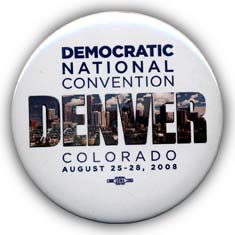 |
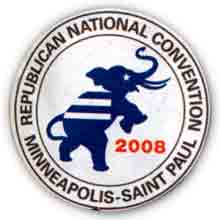 |
|---|
- The Candidates
- The Running-Mates
- The Delegates
- The Protests
- The Women
- The Show
- The Sideshow
- The Platform
2008 was an historic election year. For the first time since 1952 neither major party had an incumbent running for re-election or an heir apparent. Each party had hotly contested primary contests. Unlike 1952, each party’s nominee was known well before the conventions, having been decided by the voters in state primaries and caucuses. Convention delegates haven’t played a major role in selecting the nominee since then. The primary voters, who still tend to come from the wings rather than the middle of either party, chose nominees who would have stood little chance of winning a couple of decades ago. Instead, delegates are both an audience for the first act of the fall campaign and a magnet for all the groups who want to be heard. The national nominating conventions have become sites for political fairs in which multiple vendors exhibit their wares.
The Democrats met on August 25-28, in Denver for the first time since 1908. The press briefings and many of the daytime official meetings were held in the Colorado Convention Center (CCC) in the middle of downtown Denver. Three of the evening meetings were held in the Pepsi Center, on downtown’s edge. The final night was held in the Invesco Center, a bit further away. Its 76,000 seats were almost filled to capacity.
Republicans met the following week, September 1-4. They were greeted at the Minneapolis Convention Center (MCC) with signs proclaiming “We’ve been waiting for you since 1892” -- even though the 2008 Republican convention was actually held in the Xcel Energy Center in St. Paul. Some functions were held in MCC, including the convention committee meetings and the Sunday delegates’ welcoming party, but most were scattered throughout the twin cities (MSP).
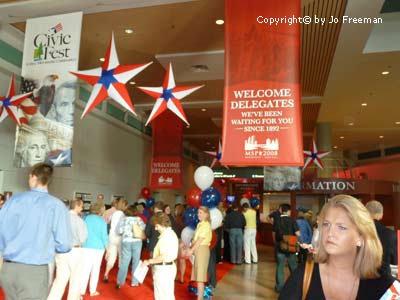
What happened at each party’s convention was shaped by their very different political cultures. The Democratic Party is a pluralistic party in which different groups organize to support candidates and make demands on the leadership. The groups which compose it change over time as the social base changes, but the party remains a coalition of constituencies. For the last few decades demographic constituencies have been at the core of the Democratic Party, though certainly not all of it.
The Republican Party is unitary, whose political culture dictates that great deference be paid to the leadership. Ideology is more important in the Republican than in the Democratic Party; groups within it are more likely to be organized around belief systems. While some ideological groups are mutually exclusive, most prioritize a particular issue arena, enabling them to ally with groups which emphasize different issues, even when they don’t agree on everything. Competing ideologies may change with time and circumstances, but their importance as organizing principles remains.
Foremost among the changes in the last few decades which altered both parties is the South’s shift from solidly Democratic to heavily Republican as the Democratic Party embraced the cause of civil rights during the 1960s. This was foreordained by a debate at the 1948 Democratic Convention over putting a civil rights plank into the platform. Although much weaker than the civil rights plank in the 1948 Republican Platform, when it passed Southern delegates walked out and ran Strom Thurmond for President as the candidate of the States Rights Party. Democratic Party candidate Harry Truman wasn’t even on the ballot in four states. When President Johnson signed the 1964 Civil Rights Act, he opined that this would cost the Democratic Party the Southern vote for at least 50 years. That year Gov. George Wallace kept President Johnson off the ballot in Alabama, running a slate of unpledged electors instead. Alabama was one of five deep-South states that voted Republican. The shift solidified in 1980. While Democrats in many states voted for Ronald Reagan in 1980, those that did so in the South continued to vote Republican. In 2008, as in previous conventions, a quarter of Republican delegates told pollsters that they had once been Democrats.
Starting somewhat later than the South, states in the Northeast and Atlantic coast trended Democratic. These states had been the home of the liberal Republicans, often called Rockefeller Republicans, who traced their roots back to Teddy Roosevelt’s Progressives. The causes of this change are more subtle; they have a lot to do with increased education and the growth of professional jobs. Before World War II the most highly educated portions of the population voted Republican; now they vote Democratic and there are more of them. Many liberal Republicans became Democrats. Those that did not found themselves being pushed out of their party as Southern conservatives moved in. Those that remain occupy a small corner of the GOP. They can elect some of their own to offices in their own states but have virtually no influence nationally. In 2008, 12 percent of the Democratic delegates told pollsters that they were once Republicans.
The election of 1980 was also the year in which the modern gender gap appeared. Women were 9% more likely to vote for the Democratic candidate for President than men. In prior elections, when there was a measurable gender gap, women were more likely to vote Republican. During the 1970s a variety of women’s issues had emerged and become salient. Initially the distribution of opinion on these issues was not partisan; by 1980 the parties had polarized with the Democrats generally favoring the feminist position and the Republicans favoring the anti-feminist position on almost all of them. However, it was issues surrounding sex (abortion, gay rights, etc) which were realigning, as candidates switched their positions to conform to that of their parties and many voters switched to the party that conformed to their views.
Although “sex” was realigning, its contribution to the gender gap was minimal. Over the next twenty years large numbers of both men and women gave up their Democratic party allegiances to become Republicans or independents, but men did so in greater numbers. The drift of white men out of the Democratic Party for a multiplicity of reasons (including race) was the biggest source of the difference in the voting patterns of men and women. While African-Americans remain among the most loyal of Democrats, there is a similar gender gap, with men more likely to vote Republican.
Since the 1960s both parties have become more diverse, but in different ways. The Democrats have become more demographically diverse and the Republicans have become more religiously diverse. This can be seen in both the candidates who sought the 2008 nomination of each party, and in the delegates to each party’s national nominating convention.
In the 2008 primaries Democratic voters were asked to choose between a black man (Barack Obama), a white woman (Hillary Rodham Clinton), a man of half-Hispanic parentage (Bill Richardson), a Southerner with a populist message (John Edwards), a Midwesterner with a leftist one (Dennis Kucinich), as well as a couple of more traditional candidates. Ideologically the Democratic candidates were very similar, leaving the Democratic primary voters to look at other things. The fact that they chose the black man and the white woman to be the frontrunners represents acceptance of fundamental changes that have taken place in the party since the 1960s.
The aspirants for the Republican party nomination personified the changes in the religious composition of their party in the last few decades. Some came from groups which were once Democrats. Mike Huckabee is an ordained Southern Baptist minister, and Rudy Giuliani, an urban Catholic. Fred Thompson was born a Southerner who was raised in the evangelical Church of Christ but only attends church when visiting his mother in Nashville. Ron Paul was raised a Lutheran in Pennsylvania, but became a Baptist when he set up his medical practice in Texas. Mormon Mitt Romney followed his father in seeking the Republican nomination. (George W. Romney got 41 votes at the 1964 GOP convention and 50 votes in 1968.) Mormons have been devoted Republicans since the 19th Century, but still struggle for acceptance within the party. The nominee, John McCain, reflected the changes that have taken place in the party in his lifetime. He was raised an Episcopalian but attends a Southern Baptist church when in Phoenix. His wife was also raised in a mainstream Protestant denomination, but she joined the Baptist church that her husband only attends. Although McCain’s personal views toward the role of government, fiscal conservatism and international affairs were very much like those of the 1964 Republican nominee from the same state, Barry Goldwater, he was not viewed as the most conservative contender in the Republican primaries. His other contribution to diversity was his age: John S. McCain was the oldest first-term nominee for the Presidency.
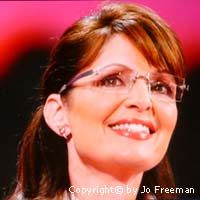 Since the Spring primaries determined who the major party nominees for President would be, the only suspense was their choices for running-mate, announced shortly before each convention began. In this, the Republicans scooped the Democrats by selecting Alaska Governor Sarah Palin, a social conservative who says she is a feminist. Both the timing and the surprise undermined the traditional polling bounce that the Democrats got from their convention, while adding to that of the Republicans.
Since the Spring primaries determined who the major party nominees for President would be, the only suspense was their choices for running-mate, announced shortly before each convention began. In this, the Republicans scooped the Democrats by selecting Alaska Governor Sarah Palin, a social conservative who says she is a feminist. Both the timing and the surprise undermined the traditional polling bounce that the Democrats got from their convention, while adding to that of the Republicans.
The first rule of picking a running-mate is do no harm; don’t choose anyone who might cost votes. When McGovern’s first choice for VP in 1972 turned out to have been treated for depression, he was quickly replaced. In 1972 any history of mental illness was a turn-off (though we now know that many Presidents have suffered from depression, including one of our greatest – Abraham Lincoln).
 One of many reasons why Obama couldn't choose Hillary Clinton despite her avid following, is that there is a strata of the voting population who thoroughly dislikes her, in addition to those who feel the same way about Bill. Those voters didn't count for much in the Democratic primaries, but they did in November. Obama didn't need the Clinton baggage. 2008 was a Democratic year. Because the election was his to loose, he needed to choose someone safe to run with. Senator Joe Biden of Delaware was a very traditional, safe choice.
One of many reasons why Obama couldn't choose Hillary Clinton despite her avid following, is that there is a strata of the voting population who thoroughly dislikes her, in addition to those who feel the same way about Bill. Those voters didn't count for much in the Democratic primaries, but they did in November. Obama didn't need the Clinton baggage. 2008 was a Democratic year. Because the election was his to loose, he needed to choose someone safe to run with. Senator Joe Biden of Delaware was a very traditional, safe choice.
McCain made a very bold and risky choice with Sarah Palin. Insofar as voters saw his Veep choice as the first example of executive decision making, McCain made a good first impression on the Republican base. He both reassured the social conservatives who were suspicious of his commitment to their views on their most important issues, and broke new ground for women. If nothing else, the media storm Palin generated brought more people to McCain’s rallies and speeches than he could have brought on his own and the enthusiasm of the base for her increased monetary contributions.
The changes in their social base that both parties have undergone since the 1960s is reflected in their 2008 delegates.
The Democrats bragged about their demographic diversity at a Sunday morning press briefing before the convention began. DNC Secretary Alice Germond said that for the first time there were slightly more women than men among the 4440 delegates. The Democratic Party Charter requires that the delegates be equally divided by gender but the presence of Superdelegates, who are often elected officials, usually tips the balance slightly in favor of men. Germond didn’t add that 55.1 percent of the black delegates were women, or provide the gender composition of any other counted groups. Tabulations from questionnaires sent to the delegates showed that African-Americans were 24.3 percent of all delegates, Hispanics were 11.8 percent and Caucasians were 56.7 percent. Germand said that 258 delegates reported that they were LGBT, but stressed that these were the ones who chose to answer that question.
The Republicans carefully avoided categorizing their delegates according to anything but geography. When asked, the convention media office said they had no information on how many women, or any other group, could be found among the 2,380 delegates. However, according to a CBS/NYT survey of 854 delegates, 32 percent of the delegates were women. This was down from 43 percent in 2004. The same survey found that 93 percent of the Republican delegates were white and 5 percent were Hispanic. The survey didn’t ask about sexual orientation, but a spokesman for the gay Log Cabin Republicans said “about two dozen” delegates and alternates were known to be LGBT.
In the 19th Century and for much of the 20th, most African Americans were Republicans. The Democratic party was the white man’s party, and not just in the South. While the voice of blacks within the Republican party was small, they were still present on the National Committee and as delegates to the national convention long before they appeared in Democratic bodies. In 1932 there was not a single black delegate at the Democratic Convention while there were 26 (2.2%) at the Republican Convention. That has changed for the Democrats. The Joint Center for Political Studies counted 36 black Republican and 1079 black Democratic delegates to the 2008 conventions. The biggest leap into the Democratic Party came between 1968 (6.7%) and 1972 (14.6%) as a result of the new delegate selection rules.
Democratic women also benefitted from these rules. Between 10 and 14 percent of Democratic delegates were women until 1972, when their participation jumped to almost 40 percent. Since 1980, Democratic rules have mandated equal division by gender so the difference is insignificant. There is no equivalent requirement for equal division for delegates to the Republican convention (though there is for participation on the convention committees). Prior to 1972, women were between 10 and 17 percent of delegates to the Republican conventions. At that convention they jumped to almost 30 percent, and stayed above that in subsequent conventions. While women have been as much as 48 percent of Republican delegates (in 1984) they only get over 40 percent of the delegate slots when an incumbent is seeking re-election. When there is a contest for the Republican nomination, even when the outcome is expected, women are usually about one-third of the delegates. In those years women come to the convention as alternates.
The religious diversity of Republican delegates has increased over time. At one time the Republicans were the Protestant party. In 2008, only 57 percent of the delegates were Protestant; 30 percent were Catholic and 3 percent were Jewish. Since the CBS/NYT survey first asked that question in 1976, Protestants have decreased from 73 percent and Catholics have increased from 18 percent of the delegates. Jews have fluctuated between 2 and 3 percent. Questions about being a born again or evangelical Christian were first asked in 1996. By then Southern whites had completed the transition to become predominantly Republican voters. Since evangelicals are heavily concentrated in the South, their presence was reflected in the 31 percent of delegates who acknowledged that affiliation in 1996 and 2008. Not enough Muslims go to either convention as delegates to register on a survey.
Religious diversity of Democratic delegates has remained pretty stable since the question was first asked in 1972. Delegates have remained a little over 40 percent Protestant, 26 percent Catholic and 9 percent Jewish. Only 5 percent of Democratic delegates are white evangelicals.
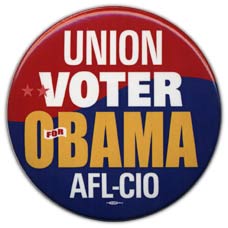 Traditionally, the Democratic Party was the party of the working class, while the GOP was the party of the middle class. This is no longer as true as it once was but the partisan shift of voters with less education and income is not reflected in the delegates; the personal costs of going to a convention favor the better-off in both parties. The historic pattern can be seen in the number of delegates who belong to labor unions. In 2008 a quarter of Democratic delegates were members of labor unions; only 5 percent of Republican delegates belonged to unions. Since the 1940s, organized labor has been the most important organized interest group within the Democratic Party. It devotes considerable resources to elect Democrats at all levels and union households vote Democratic. Ironically, the husband of the Republican nominee for Vice President, Todd Palin, was one of the 6 percent of Republican voters who belong to labor unions – a member in good standing of the United Steelworkers.
Traditionally, the Democratic Party was the party of the working class, while the GOP was the party of the middle class. This is no longer as true as it once was but the partisan shift of voters with less education and income is not reflected in the delegates; the personal costs of going to a convention favor the better-off in both parties. The historic pattern can be seen in the number of delegates who belong to labor unions. In 2008 a quarter of Democratic delegates were members of labor unions; only 5 percent of Republican delegates belonged to unions. Since the 1940s, organized labor has been the most important organized interest group within the Democratic Party. It devotes considerable resources to elect Democrats at all levels and union households vote Democratic. Ironically, the husband of the Republican nominee for Vice President, Todd Palin, was one of the 6 percent of Republican voters who belong to labor unions – a member in good standing of the United Steelworkers.
There were a few other areas in which Democratic and Republican delegates showed significant differences in 2008. Sixty percent of Republican delegates have a gun in the household and 26 percent are members of the National Rifle Association. Among Democratic delegates, 33 percent had a gun in the household but only 2 percent were members of the NRA. More Republicans (23%) than Democrats (14%) had served in the military.
Protests have become a tradition, often for causes remote from the nominating conventions. Prior to 2004 more people protested at the Democratic than the Republican Convention, even when the Republicans were the party in power. In 2004 and 2008 the Republican protests were much larger than those at the Democratic Convention. In both Denver and MSP different protest groups planned a week’s worth of activities, some of them worked together, and some didn’t. Most groups planned peaceful, nonviolent and educational events. However at each convention there were a few whose battle plans included provoking the police, blockading the streets and property destruction. Such intent was not a secret, and was generally expressed in public statements with the code phrase “diversity of tactics will be respected.”
The response to this protest tradition by law enforcement has been to significantly expand the police presence by bringing in many more cops from jurisdictions far away, providing special training in crowd control techniques and turning buildings normally used to store things into detention centers to store people. Denver and MSP were each given a $50 million federal grant to pay for convention security. At both the 2004 and 2008 Republican conventions police used “preventive arrests” to take potential troublemakers off the streets. The sweeps were undiscriminating; caught in the police net were many peaceful protestors, observers and innocent bystanders. This is unconstitutional, but police apparently feel it is better to deal with the legal problems later. At the 2008 Republican convention a few dozen journalists were included in the round-ups, though it was unclear whether this was deliberate. Charges against journalists were later dismissed.
In Denver mostly leftwing local groups wanted to Recreate ‘68– the violent confrontation with police on Michigan Ave. outside of the headquarters hotel of the 1968 Democratic Convention in Chicago. The police preferred containment. On Sunday before the 2008 convention several hundred people gathered for a rally on the Capitol steps, followed by a march down a major, but deserted, street to the Pepsi Center. At different points along the way some lay down in the street for a "die-in".
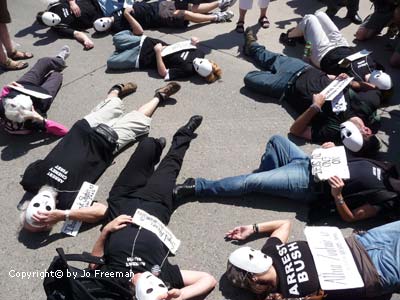
When they reached the Pepsi center protestors faced rows of black-clad cops. With both police and protestors melting in the 90-degree heat, a few protesters baited the cops with verbal taunts, while others tried to continue the march to its designated ending point a quarter-mile away. The split effectively ended the march on a rather limp note.
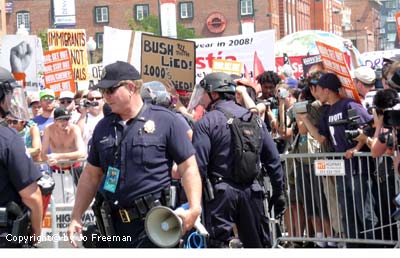
The largest number of arrests came on Monday evening when a small group of anarchists with faces covered marched toward the civic center. Their public pronouncements implied that they intended to assault the downtown delegate hotels. The police blocked their march and drove them into the civic center park, where 106 people were arrested, most of whom had gathered merely to observe the melee. At one point, the Denver police sought to “arrest” some undercover cops among the demonstrators in order to remove them. When these officers pretended to resist arrest, an officer from a different jurisdiction, unaware of the sham, fired pepper spray into their faces to subdue them.
The total number of arrests for convention related activities came to slightly over 150.
Soon after the GOP selected MSP to host its 2008 convention, a wide variety of groups came together to plan protests. The Coalition to March on the RNC and Stop the War was broader both geographically and ideologically than Denver’s Recreate ‘68, including many labor unions and local community groups. Among them was the RNC Welcoming Committee which describes itself as anarchist and anti-authoritarian. The sheriff’s office and the FBI placed moles into the working group and based on their affidavits a judge authorized search warrants for their convergence center and three homes. After raids on August 29 and 30, 8 people were arrested and charged with felony conspiracy (In 2010, after two years of legal wrangling, the charges against three of the 8 were dismissed; five pleaded guilty to misdemeanors, of whom one was sentenced to serve 91 days in jail).
On Monday about 25,000 people marched from the State Capitol over the bridge to the Xcel center but police would not let them get as close to the convention as originally allowed by their permit. Earlier, a few hundred demonstrators had left the march and slipped around police lines in order to blockade ramps, bridges and intersections. Some smashed windows in stores and cars. When the police arrived the blockaders scattered only to regroup at other intersections. The police used pepper spray to disperse those who linked arms in front of the delegate buses. Police and protestors skirmished all over downtown St. Paul. By the end of the day 256 people had been arrested, 119 on felony riot charges.
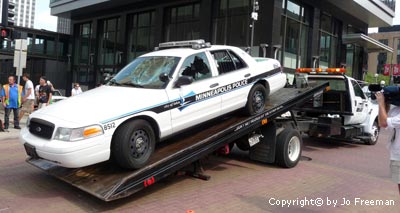
Tuesday was relatively peaceful; only ten were arrested. Very late Wednesday night, a group of rather raucous people leaving a free rock concert were met by police. When they failed to disperse promptly, 102 were arrested, mostly for unlawful assembly and obstructing traffic. Thursday, another rally at the State Capitol led to 396 arrests. When their permit expired at 5:00 p.m. several hundred people set off for the Xcel center hoping to take the media spotlight off of the Republican acceptance speeches. On finding the bridges blocked they moved into side streets and eventually regrouped. When they wouldn’t disperse, most were arrested.
Arrests for convention-related activities totaled 818.
The most visible protests weren’t the big mass marches (which weren’t all that big), but the sidewalk witnessing and disruptions of meetings by much smaller but far more creative groups. In particular CodePink, the women’s peace organization, and remnants of Operation Rescue, a pro-life group that had mounted major demonstrations at past conventions, were seen by more bystanders than saw any of the marches.

A couple of CodePinkers pulled off multiple protests every day at both conventions. Although their numbers were small, their message was clear and they did their thing where they could be seen by more than their supporters. CodePink has a talent for getting inside closed events and past security guards on the watch for protestors. Two were dragged out of Republican Convention seats each of the last two nights when they tried to unfurl their banners. While few saw them, the disapproving crowd drowned out the speaker with its chants of “USA, USA.”
One CodePinker was arrested at the Democratic convention and six at the Republican Convention.
Anti-abortion groups protested only at the Democratic convention. They appeared outside of most events hosted by women’s groups, held very large signs outside the CCC and disrupted meetings within it, including the women’s caucus, the black caucus, and the DNC’s interfaith gathering. While those inside were quickly drowned out by chants and then escorted out of the meetings by security, police allowed them to stay on the sidewalks.
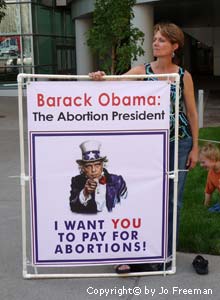
Women have been integrated into both parties. At a press briefing the Sunday before the convention, House Speaker Nancy Pelosi introduced her three convention co-chairs – all women.
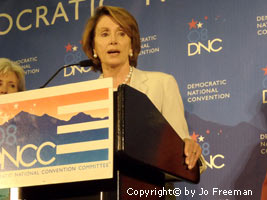
Nancy Pelosi
The CEO of the Democratic Convention was a woman, as were four of the seven members of her “leadership team.”

JoAnn Davidson
On the Republican side, the convention chairs were men, but RNC Co-chair JoAnn Davidson was chair of the Committee on Arrangements, which was responsible for planning and management of the convention. A former speaker of the Ohio House of Representatives, Davidson is “liberal” on social issues such as abortion and gay rights, but keeps quiet about it. The CEO of the Republican Convention was also a woman, as were three of her eight top staff members.
As a coalition of constituencies, the Democrats sponsor meetings of various caucuses at each convention. In 2008 nine or ten of the 13 caucuses were demographic. The Asian American Pacific American, First Americans, Ethnic Co-ordinating Council, Seniors, Rural, Hispanic, LGBT, and Black caucuses met on Monday and Wednesday. On Tuesday and Thursday the caucus rooms were taken over by the Women, Disability, Faith, Veterans and Military Families, and Youth caucuses. Participation ranged from less than 20 for the Rural Caucus to over 200 at LGBT.
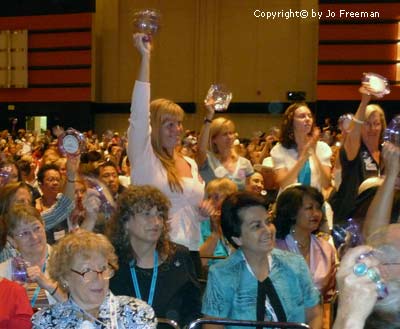
Meeting quadrennially since 1976, the women’s caucus is one of the oldest and usually the largest. The caucuses are no longer meetings where the audience participates in a discussion of issues; they have become rallies in which speakers pump up the crowd to support Democratic candidates. At most previous conventions the nominee-to-be addressed the women’s caucus; this year Sen. Obama didn’t address any of the caucuses. Several prominent women spoke to the women’s caucus. Many urged the thousand or so women in the audience to run for office themselves as well as support other women candidates. Thursday was Michelle Obama day. Buttons and bios were passed out to get the crowd ready and a copy of Ebony magazine with Michelle Obama on the cover was placed on every chair.
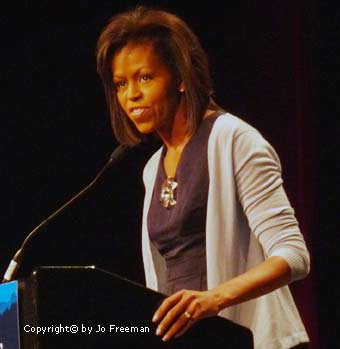
Michelle Obama
Republicans don’t hold caucuses; they go to receptions. At this convention there weren’t any receptions specifically aimed at women, though women were organizers of some. The National Federation of Republican Women usually hosts a luncheon for the wife of the candidate and sometimes runs an information service for the press. This year the largest women’s political organization in the US was invisible at the Republican convention. The WISH list, a PAC for Republican pro-choice women was a no-show.
However, Phyllis Schlafly, who became a national figure for her opposition to everything feminists stand for, held her usual event.The Republican National Coalition for Life thought it had scored a coup with Sarah Palin as the honoree at its Tuesday reception. However, a low level McCain staffer phoned founder Phyllis Schlafly late the night before and canceled. Instead of the hottest ticket in town, pro-lifers got to see CodePink demonstrating outside. The pink women said that if the RNCforLife were really pro life, it would be against War, especially the war in Iraq. Later, CodePink founder Medea Benjamin walked in front of the podium while Schlafly was speaking with a sign declaring “Be Pro-Life, Stop War.” She was dragged out by security.
Several groups held events for or about women at the Democratic convention, most on Tuesday.
The National Organization for Women (NOW), the Feminist Majority Fund, the Dolores Huerta Foundation, the National Congress of Black Women and the National Association of Social Workers co-sponsored an "Equali -Tea" on Monday afternoon. Speakers paid tribute to the late Cong. Stephanie Tubbs Jones and urged feminists to get out the vote in November. Well before the event began, a dozen young people and one older man showed up with signs denouncing abortion. Feminists came out with their own signs and the two groups had a turf battle on the sidewalk.
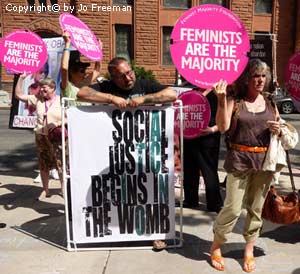
WomenCount, started in the Spring to support Hillary Clinton’s presidential bid, held a luncheon with Hillary as the main draw. (After her campaign ended, WC split into two permanent organizations: a PAC to support candidates, and an advocacy organization prioritizing women’s issues). A few blocks away, Emily's List, the pre-eminent PAC for pro-choice Democratic women, sold out all 2500 tickets to its reception at $50 to $5,000 per person.
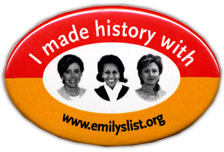
Later, the National Women's Political Caucus attracted about 75 women at $20 each to hear a panel on "Women, Politics and the Media." On Wednesday, the White House Project celebrated its 10th anniversary during the nominating speeches and vote.
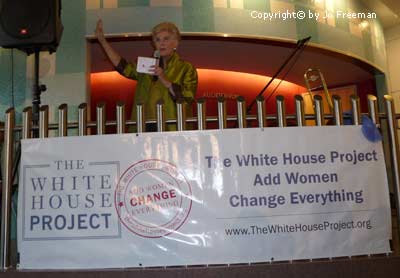
Marie Wilson speaks.
The venues of both conventions had historic significance for women. When the Democrats last met in Denver in 1908, Colorado was one of only four states in which women had equal suffrage with men. Two women from these states were delegates and two were alternates to the 1908 convention. Equal representation of men and women on party committees also originated in Colorado. It was initiated, though not fully practiced, by the Populist Party in the 1890s and eventually adopted by both major parties. The Colorado legislature made it law in 1910. By the time the national committees increased their membership to one man and one woman from each state in the 1920s, the idea that for every man there should be a woman on all party committees was known as the Colorado Plan. The first woman to chair a state party central committee was Gertrude Lee Adams, who rose from Vice-Chair to Chair of the Colorado Democratic Party in 1914. Colorado was the site for many other firsts for political women, but I didn’t see any sign that Democrats knew this history in 2008.
They did know that the second day of the convention was the 88th anniversary of the proclamation of the 19th Amendment to the US Constitution and loaded the Tuesday agenda with events by and for women. Eight women Senators were honored that evening. (Eight women Representatives were similarly honored on Wednesday night). Hillary Clinton, the first woman to win numerous primaries in the race for the nomination, was the closing speaker. She paid tribute to the suffragists who had made it all possible and pointed out how much had changed since 1920. “My mother was born before women could vote,” she said. “But in this election my daughter got to vote for her mother for President.”
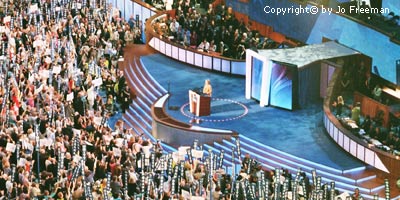
Hillary Clinton
A week later, JoAnn Davidson, Co-Chair of the Republican National Committee, also acknowledged her suffragist predecessors. She reminded her audience that women as an organized part of the Republican Party had made their debut at the 1892 convention. In an address to the delegates, Iowa lawyer J. Ellen Foster announced the formation of the Woman’s National Republican Association. “We have come to help you and we are here to stay,” she told the delegates assembled in Minneapolis’ Industrial Exposition Building. Women have been a major contributor to Republican campaigns since then.
The convention itself has long ceased to be a decision-making body. Now it is a show, the opening act to the fall campaign. At the show, the parties highlight their themes and also try to steal each other’s clothing. In 2008, the Democrats’ motif was “Change” but they also struck the notes of faith and patriotism. The Republicans emphasized “Country First” but also played up reform and peace. While specifics are in the speeches, visual images are used to emphasize the themes. Knowing that the TV cameras will often scan the crowd, especially during applause pauses, convention managers supply the signs that they want the TV audience to see. No one is allowed to bring in their own.
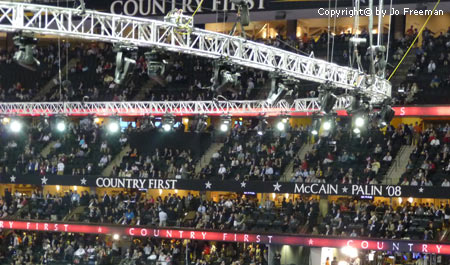
The overarching theme at the Republican Convention was “Country First”

Each night featured a different sub theme. Signs saying Service, Prosperity, Reform and Peace were passed out to be waved by the crowd when they wanted to show their enthusiasm.
Change was the Democratic theme, but signs saying “Unity,” “ONE Nation” and “Common Purpose” were in abundance on different nights.
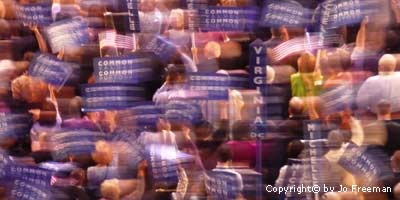
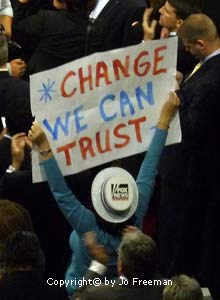
The McCain - Palin campaign was also running against the Bush administration. The Democrats asked for “Change We Need” while the Republicans countered with “Change We Can Trust.”
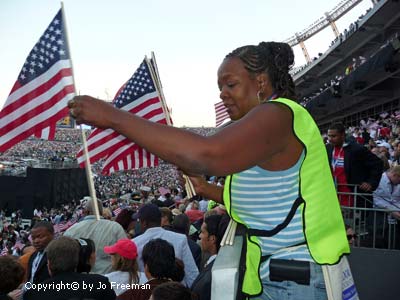
To demonstrate patriotism the Democrats passed out American flags to anyone and everyone. At the Republican convention, flags were visible only on stage.
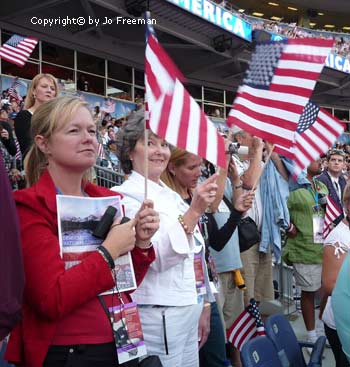
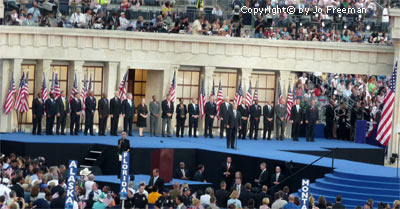
Democrats also brought out the military. Almost two dozen retired flag rank officers lined up to show their support for the Democratic nominee.
The conventions are magnets for many people who want to organize activities that are only tangentially related to the business of the convention. In addition to the protests, people come to promote their ideas and their causes through a variety of policy panels, rallies, lectures and alternative conventions. Here too the different cultures of the parties can be seen. The side shows at the Democratic Convention tend to be based in specific constituencies, sometimes organized, and sometimes not. Those at the Republican Convention are more likely to be issue-based, or formed around an ideological perspective. One can think of the various convention events as a series of concentric circles. At the outer ring are those that are generally open to anyone, though there may be a ticket charge. As one moves closer to the center, the events become more exclusive; by invitation only and/or relying on the convention organizing committee to provide space.
Organized labor brought 2,500 union members and their families to a rally in the CCC on the Sunday before the convention began to hear AFL-CIO President John Sweeney and Change- to-Win President Anna Burger tell them to get out the vote for the Democratic ticket. Other speakers identified the messages that labor would use to appeal to the working class during the campaign. Although labor is the biggest organized constituency within the Democratic Party, there is no Labor caucus organized by the DNC. Unions have their own offices, hold their own press conferences and organize their own meetings at the convention. Roughly one thousand of the Democratic delegates were union members, most selected by their local unions.
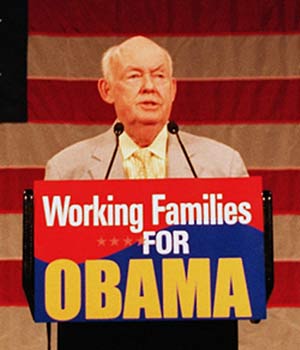
John Sweeney
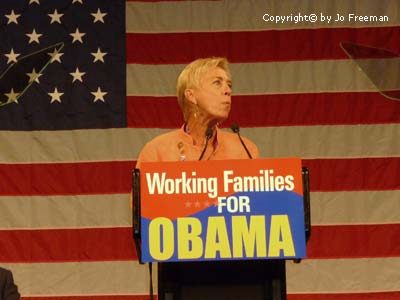
Anna Burger
Progressive Democrats of America held an alternative convention at a Denver church where anyone wishing to come heard lefty notables like Tom Hayden, Katrina vanden Heuvel, and Jim Hightower speak on the importance of universal health care and getting out of Iraq. First organized at the 2004 Democratic Convention from people who had supported the candadicies of Howard Dean and Dennis Kucinich, PDA aims to mobilize grassroots Dems to push the party to the left.
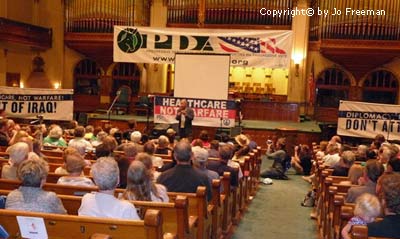
Tom Hayden addresses PDA
The American Muslim Taskforce on Civil Rights and Elections sponsored a four-day program of receptions, strategy meetings, and lectures throughout the Democratic convention. Among the many Members of Congress to address the AMT was former candidate Dennis Kucinich who explained why he had introduced a bill to indict President Bush and his top aides. Muslims voted for Bush in 2000, but returned to the Democratic column in 2004. Nativo Lopez, National President of the Mexican American Political Association, analyzed the immigration debate and journalist Amy Goodman denounced the corporate media. The atmosphere wasn't as friendly at the Republican convention where about one hundred people attended an AMT ice cream social. Of the Republican candidates, only Ron Paul acknowledged Muslim support. Three other candidates (Giuliani, Romney and Huckabee) made speeches that the AMT characterized as "Islamophobic."
Libertarian Congressman Ron Paul (R-TX) held his own “Rally for the Republic” on Tuesday during the Republican Convention. Held at the Target Center in downtown Minneapolis, 10,320 tickets to the rally were sold for $17.76 each, and another 1,000 were given out at the door. Paul had run for the Republican nomination for President in the Spring, but stopped his campaign to turn his mostly online following and remaining $4.7 million in contributions into an ongoing organization which he called the Campaign for Liberty . His goal is to return the Republican Party to its conservative beliefs in limited government, free markets, personal liberty and peace. Ron Paul opposed the war in Iraq; followers carrying his signs marched during most of the 2007 anti-war demonstrations. He was the only Presidential candidate with a visible contingent at these demonstrations. Paul received the votes of 15 delegates at the Republican convention
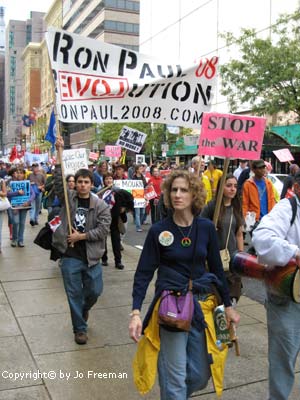
Anti-Iraq war march in Philadelphia Oct. 27, 2007
Holding much smaller meetings on the same Tuesday were two groups who longed for the Republican Party to be a Big Tent.
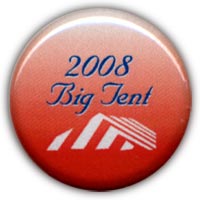 At noon about 160 LGBT conservatives paid to hear former Arizona Cong. Jim Kolbe tell them that "we are making great progress" in becoming an inclusive party. The Log Cabin Republicans believe that Lincoln was secretly gay, hence the name. McCain’s National Political director asked the LCRs to "reach-out" and bring all voters to McCain. He said that McCain is a "very inclusive" guy. This is "great progress" from 1995, when Bob Dole's campaign returned the group's $1,000 campaign contribution. The LCR Board endorsed John McCain, later claiming that the exit polls showed that he received 27% of the gay vote in November – up from 20% in 2004.
At noon about 160 LGBT conservatives paid to hear former Arizona Cong. Jim Kolbe tell them that "we are making great progress" in becoming an inclusive party. The Log Cabin Republicans believe that Lincoln was secretly gay, hence the name. McCain’s National Political director asked the LCRs to "reach-out" and bring all voters to McCain. He said that McCain is a "very inclusive" guy. This is "great progress" from 1995, when Bob Dole's campaign returned the group's $1,000 campaign contribution. The LCR Board endorsed John McCain, later claiming that the exit polls showed that he received 27% of the gay vote in November – up from 20% in 2004.
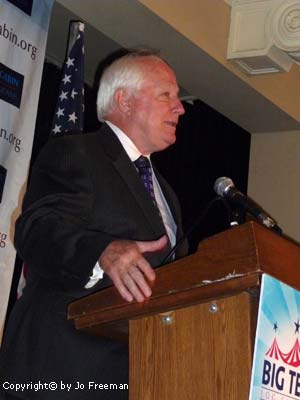
Former Cong. Jim Kolbe at the Log Cabin luncheon
What’s left of the liberal wing of the GOP, now known as the moderate Republicans, paid between $250 and $5000 per ticket to go to a "Big Tent Celebration" sponsored by the Republican Majority for Choice. Abortion is the issue which brings them together, even though it has been a losing issue. For years they fought — and lost — the inclusion of anti-choice language in the Republican Party Platform. In 2008, they didn't even try. Nonetheless, they still believe that they are "the real majority" in the Republican party.
Basically nothing changed – at least not for women – in the party platforms. Those groups which have the strongest personal investment in the platform language kept what they had won previously. In the Democratic Party feminists long ago wrote the basic planks concerning women. The winning candidate writes the platform and the Obama campaign was satisfied with the feminist positions in it. The McCain campaign didn’t agree with all of the planks in the Republican Party platform, but since the social conservatives would have fought over every word, the campaign decided to leave well enough alone. As Bob Dole pointed out in 1996, when it comes to winning or governing, the party platforms don’t much matter.
Books by Jo | What's New | About Jo | Photos | Political Buttons
Home | Search | Links | Contact Jo | Articles by Jo